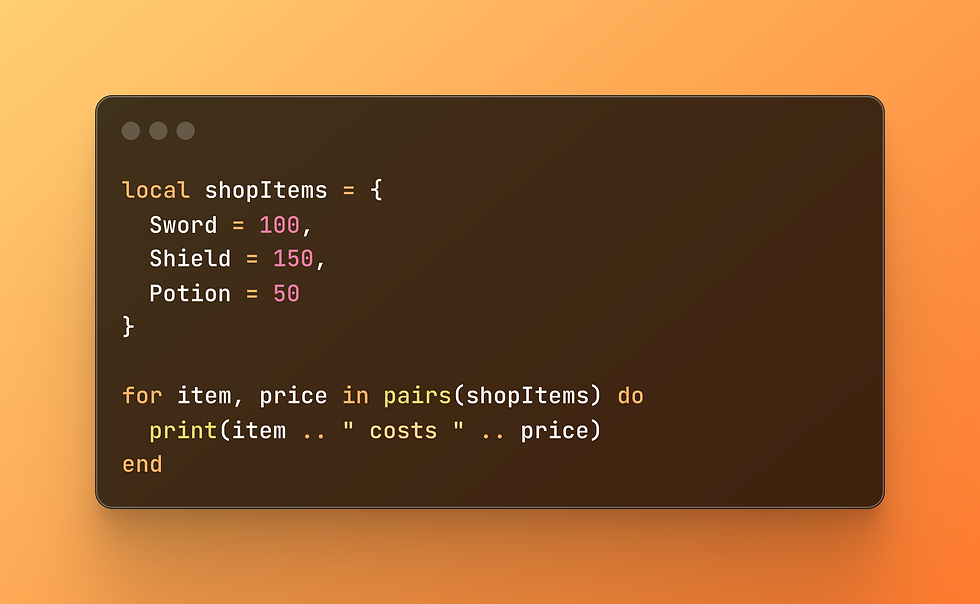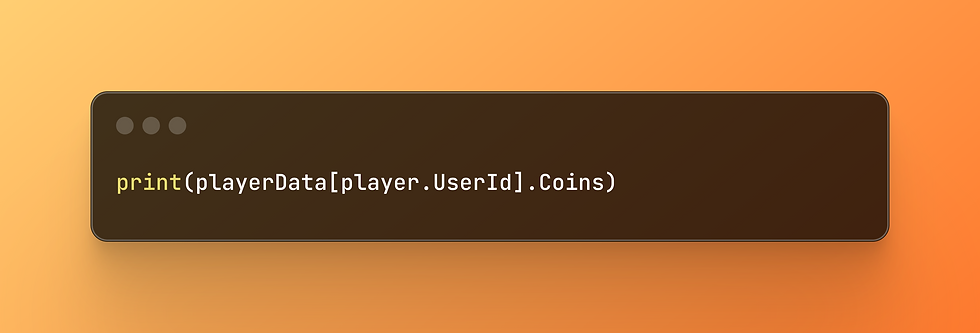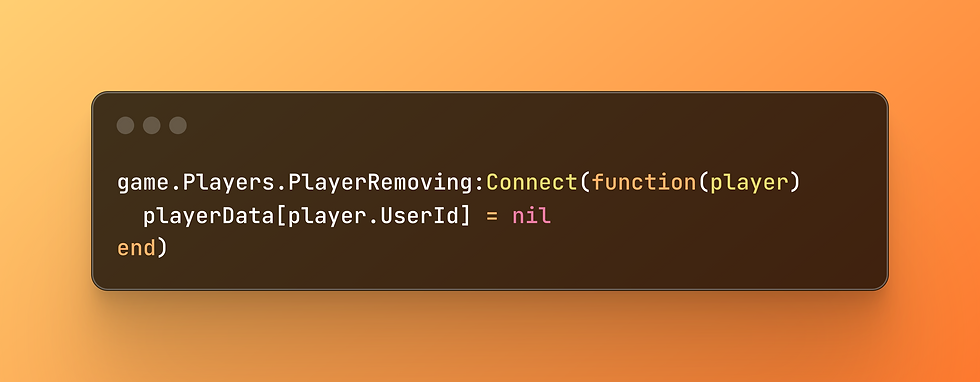Roblox Dictionaries and Arrays: Organizing Your Game Data Like a Pro
- Primal Cam
- Aug 16
- 4 min read
When you’re building Roblox games, you’ll quickly realize you’re juggling lots of data:
A list of players on a leaderboard
The stats of each pet in your simulator
The shop items and their prices
The quests and whether they’re complete
If you tried to manage all that with individual variables, you’d drown in spaghetti code. That’s why Roblox gives us two powerful tools: Arrays and Dictionaries.
Think of them like this:
Arrays = ordered lists (like a to-do list).
Dictionaries = labeled data (like a toolbox with names on each drawer).
By the end of this guide, you’ll know how to choose the right one, loop through them efficiently, and apply them to real game systems.
1. What is an Array?
An array is just a list of values in order.

Arrays always start at index 1 in Lua (unlike some other languages that start at 0).
Key point: Arrays are best when order matters. For example:
The order of waves in a survival game
The stages in an obby
The top 10 scores on a leaderboard
2. What is a Dictionary?
A dictionary is like a table where each item has a key (name) instead of just a number.

Dictionaries are best when you want labels instead of numbers. For example:
Storing each player’s currency by UserId
Matching item names to their prices
Mapping quest names to their progress
3. Choosing Between Them
So, which one should you use?
Use arrays when order matters.
Use dictionaries when labels matter.
Example:
Array → {100, 200, 300} (player XP milestones)
Dictionary → {Coins = 500, Gems = 20} (player stats with labels)
4. Loops + Arrays
Arrays are meant to be looped through.

Output:

This is perfect for spin wheels, drop tables, or inventory slots.
5. Loops + Dictionaries
Dictionaries don’t have indexes, so you use pairs instead of ipairs.

Output order isn’t guaranteed, because dictionaries don’t care about sequence—only labels.
6. Use Case: Shop System
Imagine a Roblox shop. You could store items and prices in a dictionary:

When a player clicks an item, you just check the dictionary:

This makes updating your shop as easy as adding or removing entries. No hard-coded if checks needed.
7. Use Case: Leaderboards
Arrays are great for rankings because order matters.

Add a new score, sort it, and display:

Now your array automatically updates in descending order.
8. Use Case: Pets and Upgrades
A hybrid approach (dictionary inside an array) is common in Roblox.

This is exactly how many simulators store pets, eggs, and upgrades—arrays for order, dictionaries for attributes.
9. Dynamic Player Data
Let’s say you want to track multiple stats for each player. A dictionary keyed by UserId is the way to go.

Now you can access it anytime:

When they leave, just clear it:

This keeps your server memory clean.
10. Arrays vs Dictionaries in Game Design
Here’s a quick cheat sheet:
Use Case | Best Choice | Why |
Leaderboards | Array | Order matters |
Shop Items | Dictionary | Easy lookups |
Pets/Upgrades | Hybrid | Both labels + order |
Player Data | Dictionary | Keys by UserId |
Cutscene Steps | Array | Sequence of actions |
11. Advanced Tips
Mix and match. It’s common to see dictionaries inside arrays, or arrays inside dictionaries.
Use table.insert and table.remove for arrays.
Use pairs carefully. Order in dictionaries isn’t guaranteed, so don’t rely on it.
Server memory. Always clean up player dictionaries on PlayerRemoving.
Serialization. DataStores often save dictionaries, since they’re easy to load/save as JSON.
12. Common Mistakes
Using the wrong loop type.
ipairs for arrays (ordered).
pairs for dictionaries (unordered).
Forgetting cleanup.If you don’t nil out player data dictionaries, memory leaks can build up.
Over-nesting.Arrays inside dictionaries inside arrays inside dictionaries = pain. Keep structures simple.
Mixing data types.Don’t mix strings, numbers, and dictionaries randomly in the same array. Stick to a consistent format.
13. Teaching Arrays and Dictionaries With Mini-Projects
A few fun ways to help new devs practice:
Array Game: Create a spin wheel that picks a random item from an array.
Dictionary Game: Build a shop where items and prices are pulled from a dictionary.
Hybrid Project: Pet system with an array of dictionaries (name, power, rarity).
Leaderboard Project: Insert scores into an array and sort them dynamically.
Each one cements the mental model of lists vs labeled drawers.
14. Final Checklist
Before shipping, ask yourself:
Did I use an array where order matters?
Did I use a dictionary where labels matter?
Am I looping with pairs or ipairs correctly?
Did I clean up player data on exit?
Is my data structure simple and consistent?
Final Thought | Roblox dictionaries and arrays
Arrays and dictionaries are the unsung heroes of Roblox scripting. They don’t flash like particle effects or popups, but they quietly organize your game’s brain.
Learn to choose the right one at the right time, and your scripts go from clunky variables to clean, professional systems.
So next time you start coding, ask:Do I need order? Or do I need labels?
That single question will tell you whether you’re looking at an array, a dictionary, or both.

$50
Product Title
Product Details goes here with the simple product description and more information can be seen by clicking the see more button. Product Details goes here with the simple product description and more information can be seen by clicking the see more button

$50
Product Title
Product Details goes here with the simple product description and more information can be seen by clicking the see more button. Product Details goes here with the simple product description and more information can be seen by clicking the see more button.

$50
Product Title
Product Details goes here with the simple product description and more information can be seen by clicking the see more button. Product Details goes here with the simple product description and more information can be seen by clicking the see more button.




Comments